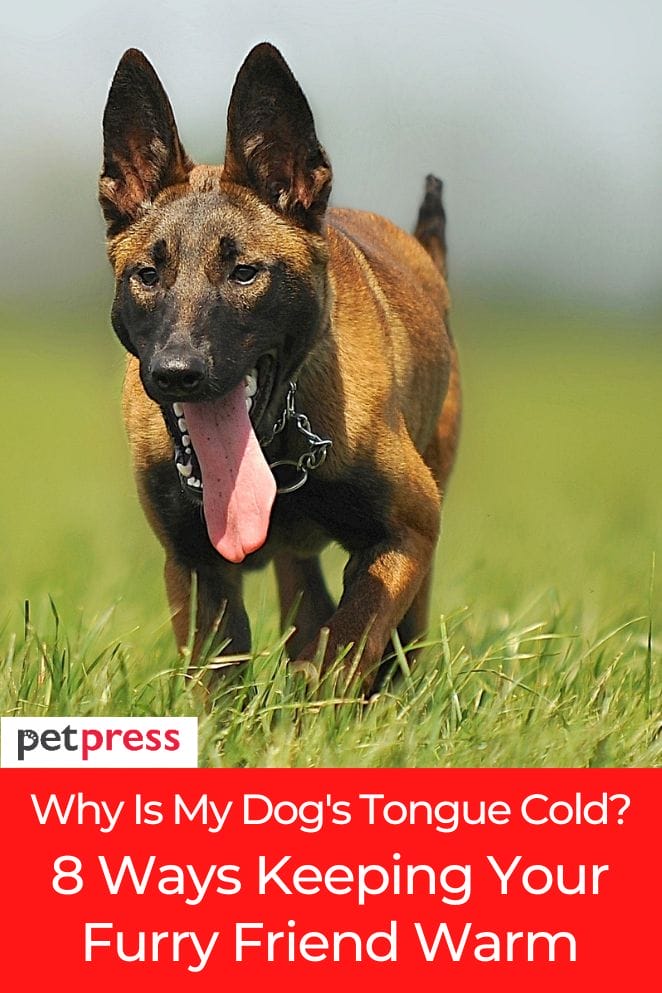
We’ve all experienced it, haven’t we? That moment when we reach out to pet our beloved canine companions, only to encounter the cool, slightly chilly sensation of their tongue.
It’s a relatable experience for most dog owners, often prompting the question, “Why does my dog’s tongue feel so cold?”
Well, prepare to embark on a captivating journey into the world of canine biology as we unveil the mysteries behind this fascinating occurrence.
Plus, we’ve got some fantastic advice to ensure your furry friend remains warm and snug during those brisk days.
Why Is a Dog’s Tongue Cold?

A dog’s tongue feels cold for several reasons, all of which are perfectly normal and vital for their well-being.
Temperature regulation
When it comes to regulating body temperature, dogs have a rather unique approach, quite distinct from our human counterparts.
While we humans rely mainly on sweating to cool down, our canine companions have evolved their own ingenious cooling mechanism: panting.
This behavior becomes especially vital for them when they need to shed excess heat and maintain a comfortably balanced body temperature.
So, let’s take a deeper dive into the inner workings of this remarkable cooling system and uncover why a dog’s tongue often imparts that refreshing coolness when we touch it.
Blood circulation
Dogs have a highly efficient circulatory system that circulates blood throughout their bodies, including their tongues.
This circulatory system is essential for regulating their body temperature through panting and supporting sensory functions like taste.
The system dynamically adjusts blood flow to the tongue, allowing for effective cooling and sensory perception.
Hydration
Just as with humans, proper hydration in dogs is fundamental to various bodily functions, including the regulation of their tongue’s temperature.
A hydrated dog typically enjoys a refreshing sensation in their mouth, but dehydration can lead to its tongue feeling warmer than usual.
Therefore, it is of utmost importance to provide your furry friend with consistent access to clean, fresh water at all times.
Natural variations
Another aspect to consider in this intriguing equation is the natural variations in a dog’s body temperature, which can influence how their tongue feels to the touch – whether warm or cool.
These variations are influenced by a medley of factors, including breed, age, and activity level.
For instance, certain dog breeds exhibit a higher predisposition to heat sensitivity, while older dogs might undergo changes in their circulation and metabolic rate, thereby affecting the perceived temperature of their tongue.
Understanding these unique variations adds yet another layer to the captivating tapestry of canine physiology.
Panting
Panting is a natural cooling mechanism deeply rooted in a dog’s evolutionary biology.
It involves the evaporation of saliva from their tongues, similar to how humans sweat, to dissipate excess heat from their bodies.
This process is aided by dilated blood vessels in the tongue, allowing cooled blood to circulate throughout the system.
Dogs commonly pant when exposed to high temperatures, during exercise, or when stressed, as it helps them regulate their internal temperature.
Tips for Keeping Your Dog Warm

While a dog’s cold tongue is a natural part of its physiology, it’s crucial to ensure its overall warmth and comfort, especially during colder seasons.
Here are some tips to keep your canine companion snug:
Cozy bedding
Providing your dog with a warm and comfortable bed or blanket to sleep on is crucial.
Just as we appreciate a warm and soft place to rest, dogs also benefit from a comfortable spot. Elevated beds can be especially helpful in keeping them off cold floors, which can sap their body heat.
Proper clothing
In extremely cold weather, consider using doggy sweaters or coats to provide extra insulation.
While dogs have fur to keep them warm, some breeds and smaller dogs are more susceptible to the cold.
Outfitting them in a well-fitted sweater or coat can make a significant difference in keeping them warm.
Limit outdoor exposure
On chilly days, it’s a good idea to reduce the time your dog spends outdoors.
When they do go out, ensure they are adequately protected with a jacket or booties.
These protective items can shield them from the biting cold and prevent their paws from coming into contact with freezing surfaces like ice and snow.
Nutritious diet
Keep your dog well-nourished and hydrated, as this helps them generate the necessary internal heat.
Providing ample fresh water is crucial, as dogs can become dehydrated even in cold weather.
Additionally, consider adjusting their food intake according to their activity level, as more active dogs may require extra calories to stay warm.
Indoor comfort
Ensure that your home is adequately heated during cold spells.
Dogs, like humans, appreciate a warm indoor environment.
Avoid drafts by sealing any gaps around doors and windows.
Creating a cozy corner with their bed or blanket in a well-heated room can become their safe haven during colder months.
Regular exercise
While it’s important to limit outdoor exposure in extreme cold, regular exercise is still vital for your dog’s overall health.
Try to schedule walks during the warmer parts of the day, and if it’s too cold outside, engage in indoor play and mental stimulation activities to keep them active and happy.
Indoor play
Engaging your dog in indoor activities and playtime serves a dual purpose.
It not only keeps them active and mentally stimulated but also helps maintain their body temperature.
Indoor games like fetch, hide-and-seek, or puzzle toys can provide an excellent source of exercise and entertainment when outdoor excursions are limited due to cold weather.
Heated beds or pads
For an extra layer of warmth and comfort, consider investing in heated beds or pads specifically designed for dogs.
These products provide a cozy, warm spot for your dog to rest and sleep.
However, it’s crucial to follow safety guidelines when using heated beds or pads.
Ensure that they are designed for pets and have built-in temperature controls to prevent overheating.
Always monitor your dog’s behavior and comfort level when introducing new heating elements to their environment.
Conclusion
A dog’s cool tongue is a truly fascinating aspect of their natural biology, intricately linked to their unique methods of temperature regulation and hydration.
Understanding this inherent characteristic allows us to develop a richer admiration for how dogs navigate their surroundings while ensuring their comfort.
When it comes to keeping your four-legged companion warm and content during colder seasons, remember to follow the practical advice we’ve shared, always prioritizing the well-being and happiness of your furry friend.
FAQs
A cold tongue alone is not necessarily a sign of illness. However, if your dog’s overall behavior or health seems off, it’s advisable to consult a veterinarian.
A very cold tongue can indicate your dog is extremely cold or possibly dehydrated. Ensure they are adequately warm and well-hydrated.
A slightly warm tongue is generally nothing to worry about. However, if your dog’s tongue feels excessively hot, it might be a sign of fever or overheating, and you should seek veterinary advice.
Signs of a cold dog include shivering, seeking warmth, curling into a ball, or appearing lethargic. Pay attention to these cues and take appropriate steps to keep your dog warm.
It’s not recommended to use human heating pads for dogs, as they can become too hot and may pose a risk. Opt for pet-specific heating pads designed with safety in mind.


GIPHY App Key not set. Please check settings